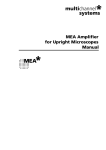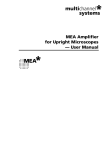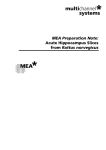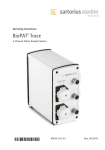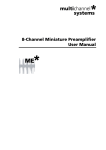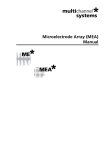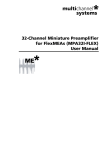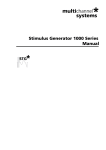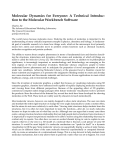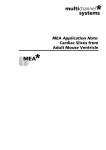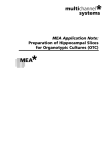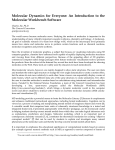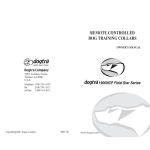Download MEA Amplifier with Blanking Circuit for Upright Microscopes
Transcript
MEA Amplifier with Blanking Circuit for Upright Microscopes — User Manual Information in this document is subject to change without notice. No part of this document may be reproduced or transmitted without the express written permission of Multi Channel Systems MCS GmbH. While every precaution has been taken in the preparation of this document, the publisher and the author assume no responsibility for errors or omissions, or for damages resulting from the use of information contained in this document or from the use of programs and source code that may accompany it. In no event shall the publisher and the author be liable for any loss of profit or any other commercial damage caused or alleged to have been caused directly or indirectly by this document. © 2004–2005 Multi Channel Systems MCS GmbH. All rights reserved. Printed: 2006-05-17 Multi Channel Systems MCS GmbH Aspenhaustraße 21 72770 Reutlingen Germany Fon +49-71 21-90 92 5 - 0 Fax +49-71 21-90 92 5 -11 [email protected] www.multichannelsystems.com Microsoft and Windows are registered trademarks of Microsoft Corporation. Products that are referred to in this document may be either trademarks and/or registered trademarks of their respective holders and should be noted as such. The publisher and the author make no claim to these trademarks. Table Of Contents 1 1.1 Introduction About this Manual 1 1 2 2.1 2.2 2.3 2.4 2.5 Important Information and Instructions Operator's Obligations Guaranty and Liability Important Safety Advice Terms of Use for the Program Limitation of Liability 3 3 3 4 5 5 3 3.1 3.2 3.3 First Use of the MEA Amplifier Welcome to the MEA Amplifier Installing the Software Setting Up and Connecting the MEA Amplifier 7 7 9 9 4 4.1 4.2 4.3 4.4 First Tests and Tutorial First Functional Tests General Performance / Noise Level Computer Connection Stimulation and Recording 13 13 13 15 15 5 5.1 5.2 5.3 5.4 5.5 5.6 5.7 5.8 Operating the MEA Amplifier Signal Amplification and Filters Temperature Control Mounting the MEA Probe and Grounding the Bath Grounding Defective Electrodes Stimulation Stimulus Artifact Suppression (Blanking) Examples with Different MEA Types Service and Maintenance 23 23 25 26 28 30 31 35 38 6 6.1 6.2 6.3 6.4 6.5 6.6 6.7 6.8 Troubleshooting About Troubleshooting Error Messages Noise on Single Electrodes Unsteady Baseline Artifacts on All Channels Unpredictable Noise and Artifacts Liquid Spilled onto Amplifier Technical Support 39 39 39 39 40 41 42 43 44 7 7.1 Appendix Technical Specifications 7.1.1 Pin and MEA Layout 7.1.2 MEA1060-Up-BC 7.1.3 FA60S-BC 7.1.4 Heating Element 7.1.5 Model Test Probe 45 45 45 48 49 50 51 i ii 7.2 7.3 Contact Information Ordering Information 52 52 8 Index 57 Introduction 1 Introduction 1.1 About this Manual This manual comprises all important information about the first installation of the hardware and software, and about the daily work with the instrument. It is assumed that you have already a basic understanding of technical and software terms. No special skills are required to read this manual. If you are using the device for the first time, please read the important safety advice before installing the hardware and software, where you will find important information about the installation and first steps. The printed manual and Help are basically the same, so it is up to you which one you will use. The Help offers you the advantage of scrolling through the text in a non-linear fashion, picking up all information you need, especially if you use the Index, the Search function, and the Browse Sequences. If you are going to read larger text passages, however, you may prefer the printed manual. The device and the software are part of an ongoing developmental process. Please understand that the provided documentation is not always up to date. The latest information can be found in the Help. Check also the MCS Web site (www.multichannelsystems.com) for downloading up-to-date manuals and Help files. 1 Important Information and Instructions 2 Important Information and Instructions 2.1 Operator's Obligations The operator is obliged to allow only persons to work on the device, who • are familiar with the safety at work and accident prevention regulations and have been instructed how to use the device; • are professionally qualified or have specialist knowledge and training and have received instruction in the use of the device; • have read and understood the chapter on safety and the warning instructions in this manual and confirmed this with their signature. It must be monitored at regular intervals that the operating personnel are working safely. Personnel still undergoing training may only work on the device under the supervision of an experienced person. 2.2 Guaranty and Liability The General conditions of sale and delivery of Multi Channel Systems MCS GmbH always apply. The operator will receive these no later than on conclusion of the contract. Multi Channel Systems MCS GmbH makes no guaranty as to the accuracy of any and all tests and data generated by the use of the device or the software. It is up to the user to use good laboratory practice to establish the validity of his findings. Guaranty and liability claims in the event of injury or material damage are excluded when they are the result of one of the following. • Improper use of the device • Improper installation, commissioning, operation or maintenance of the device • Operating the device when the safety and protective devices are defective and/or inoperable • Non-observance of the instructions in the manual with regard to transport, storage, installation, commissioning, operation or maintenance of the device • Unauthorized structural alterations to the device • Unauthorized modifications to the system settings • Inadequate monitoring of device components subject to wear • Improperly executed and unauthorized repairs • Unauthorized opening of the device or its components • Catastrophic events due to the effect of foreign bodies or acts of God 3 MEA Amplifier with Blanking Circuit for Upright Microscopes - User Manual 2.3 Important Safety Advice Warning: Make sure to read the following advice prior to install or to use the device and the software. If you do not fulfill all requirements stated below, this may lead to malfunctions or breakage of connected hardware, or even fatal injuries. Warning: Obey always the rules of local regulations and laws. Only qualified personnel should be allowed to perform laboratory work. Work according to good laboratory practice to obtain best results and to minimize risks. The product has been built to the state of the art and in accordance with recognized safety engineering rules. The device may only • be used for its intended purpose; • be used when in a perfect condition. • Improper use could lead to serious, even fatal injuries to the user or third parties and damage to the device itself or other material damage. Warning: The device and the software are not intended for medical uses and must not be used on humans. Malfunctions which could impair safety should be rectified immediately. High Voltage Electrical cords must be properly laid and installed. The length and quality of the cords must be in accordance with local provisions. Only qualified technicians may work on the electrical system. It is essential that the accident prevention regulations and those of the employers' liability associations are observed. • Each time before starting up, make sure that the mains supply agrees with the specifications of the product. • Check the power cord for damage each time the site is changed. Damaged power cords should be replaced immediately and may never be reused. • Check the leads for damage. Damaged leads should be replaced immediately and may never be reused. • Do not try to insert anything sharp or metallic into the vents or the case. • Liquids may cause short circuits or other damage. Keep the device and the power cords always dry. Do not handle it with wet hands. Requirements for the installation • Make sure that the device is not exposed to direct sunlight. Do not place anything on top of the device, and do not place it on top of another heat producing device. Never cover the device, not even partially, so that the air can circulate freely. Otherwise, the device may overheat. • Use and keep the device only in a dry environment. Fluids or damp air may damage or destroy the device. Spilled liquid can damage or even completely destroy the electronics of the MEA amplifier. Avoid it by all means. 4 Important Information and Instructions 2.4 Terms of Use for the Program You are free to use the program for its intended purpose. You agree that you will not decompile, reverse engineer, or otherwise attempt to discover the source code of the software. 2.5 Limitation of Liability Multi Channel Systems MCS GmbH makes no guaranty as to the accuracy of any and all tests and data generated by the use the software. It is up to the user to use good laboratory practice to establish the validity of his findings. To the maximum extent permitted by applicable law, in no event shall Multi Channel Systems MCS GmbH or its suppliers be liable for any special, incidental, indirect, or consequential damages whatsoever (including, without limitation, injuries, damages for data loss, loss of business profits, business interruption, loss of business information, or any other pecuniary loss) arising out of the use of or inability to use the program or the provision of or failure to provide Support Services, even if Multi Channel Systems MCS GmbH has been advised of the possibility of such damages. 5 First Use of the MEA Amplifier 3 First Use of the MEA Amplifier 3.1 Welcome to the MEA Amplifier Raw data from up to 60 electrodes of a microelectrode array (MEA) is amplified by 60 channels of pre- and filter amplifiers. The MEA sensor is placed directly into the small-sized MEA preamplifier with blanking circuit (MEA1060-BC-PA). When the amplifier is closed, the contact pins in the lid of the amplifier are pressed onto the MEA contact pads. The very close location of the amplifier to the MEA sensor is very favorable concerning a high signal-to-noise ratio. MEA amplifiers can be ordered with different gain and bandwidth configurations by the user's choice. For example, typical pass bands would be 1–300 Hz for recording field potentials and 300–3000 Hz for recording action potentials. It is also possible to use a broadband amplifier and filter the data with the digital filter of the free MC_Rack program. Gain settings from 100 to 5000 are possible. The amplifier is connected to the data acquisition computer via a single 68-pin MCS Standard cable. The analog output signals of the MEA amplifier are then acquired and digitized by the MC_Card (MEA System) or your custom data acquisition system. MEA amplifiers have an integrated heating system for controlling the MEA's temperature. The desired temperature can be easily programmed with a temperature controller. You will not need an incubator during recording — all environmental conditions are reliably controlled directly in the MEA dish. 7 MEA Amplifier with Blanking Circuit for Upright Microscopes - User Manual MEA Amplifier with blanking circuit (MEA1060-BC) With the MEA preamplifier with blanking circuit, software controls allow you to select any electrode on an MEA for stimulation and recording. You can apply two different stimulus protocols to any selection of electrodes. A blanking signal (TTL pulse) transiently switches off the input stage of the amplifiers during the stimulus, thus avoiding the stimulus artifacts on non-stimulating electrodes. Amplifier saturation is effectively prevented and the recovery time is greatly reduced. It is also possible to record from stimulating electrode shortly after stimulation. Without blanking technology, recovery time depends on the filter amplifier type. It is roughly the time constant of the high pass filter multiplied by ten. During this time, the data output is distorted. With the blanking circuit, the voltage outputs of the preamplifier are held constant during the time when the blanking input is active. Thus, the following filter amplifier does not get saturated by the stimulus artifact. When the blanking signal has stopped, the channel output follows the input signal again. With the MEA_Select program, it is easy to change the electrode selection during the experiment, for example to use stimulating electrodes for recording and vice versa. You can also ground unwanted or bad electrodes by mouse click. It is very convenient to use a stimulus generator and MC_Stimulus to set up both your stimuli and the blanking signal. You can then use the digital Sync Out output channel for controlling the blanking of the MEA preamplifier and triggering the recording with the MC_Card. 8 First Use of the MEA Amplifier 3.2 Installing the Software System requirements Software: One of the following Windows operating systems is required: Windows 2000 or Windows XP (English and German versions supported). Other language versions may lead to software errors. Hardware: Free RS232 port Installing the software Please check the system requirements before you install the software. MCS cannot guarantee that the software works properly if these requirements are not fulfilled. Important: Please make sure that you are logged in as an administrator before installation. Otherwise, is possible that the installed software does not work properly. 1. Double-click Setup.exe on the installation volume. The installation assistant will show up and guide you through the installation procedure. 2. Follow the instructions of the installation assistant. 3.3 Setting Up and Connecting the MEA Amplifier Warning: Spilled liquid can damage or even completely destroy the electronics of the MEA amplifier. Please be extremely careful when setting up your perfusion system and when starting the perfusion. Take care that the flow rates of the inlet and outlet flow match so that flooding of the amplifier is efficiently prevented. Note: The housing of the MEA amplifiers was optimized for Zeiss Axiovert microscopes. MEA Amplifiers are compatible to most standard microscopes if the following prerequisites are met. This MEA amplifier type has been developed for standard upright microscopes with a rectangular microscope table. The focal plane of the microscope has to be in a distance of 8 mm to the microscope table. Note: If you use a complete MEA System, the MEA amplifier will usually be powered by the isolated power supply (IPS10W) that is integrated into the data acquisition computer. The power is distributed along the MCS 68-Pin High Grade Cable. If you use your MEA amplifiers together with an MEA Switch, or if you use a custom data acquisition system without IPS10W, you will need an external power supply for operating the amplifier(s). Please ask your local retailer for more information on setup options. 1. Connect the MEA preamplifier with blanking circuit to the filter amplifier's input with a 68-pin MCS standard cable. 2. Connect the filter amplifier's output to the MC_Card input labeled MC_Card Ch. 01–64 (or to your custom data acquisition card) with a 68-pin MCS standard cable. If you have an MEA120 System, connect the second MEA amplifier with a 68-pin MCS standard cable to the input for channels 65–128 labeled MC_CX64 Ch. 65–128. If you are using an MEA Switch, connect the amplifiers to the MEA Switch inputs, and the MEA Switch outputs to the MC_Card. 3. Place the MEA amplifier onto the microscope table. 4. Connect the internal heating element to a Temperature Controller's output channel (D-Sub9 socket) with the black cable. (The Temperature Controller is not part of the standard scope of delivery, but is included in the MEA System and can also be ordered separately.) Do not connect the black heating element cable to the data acquisition computer. 9 MEA Amplifier with Blanking Circuit for Upright Microscopes - User Manual 5. Connect the serial port of the preamplifier to a free RS232 serial port of the computer, from which you like to control the MEA amplifier (usually the data acquisition computer) with the provided RS232 cable. Note that you need a separate Com port for each amplifier in use. 6. Connect up to two analog outputs of the stimulus generator to the two stimulus inputs of the preamplifier. Connect the corresponding ground to the ground inputs. Please see the illustrations below for details. 7. Connect a digital Sync Out output of the stimulus generator to the Trigger In input of the preamplifier with a standard BNC cable. If you use a complete MEA System, connect the same Sync Out output to the first digital input bit of the MC_Card. (Split the Sync Out output by using a T connector.) 8. You should use a Faraday cage or appropriate materials, for example aluminum foil, for shielding the amplifier. The shielding should be connected to the amplifier's ground, for example, to the screws of the cover. Please see also the separate handout "MEA — Microelectrode Systems" for setup suggestions with detailed illustrations. The following illustration shows a suggested setup for a standard MEA60 System with stimulus generator and blanking circuit. 10 First Use of the MEA Amplifier Connecting the amplifier to the stimulus generator The following illustration shows the recommended setup for connecting a stimulus generator to the MEA amplifier with blanking circuit. The amplifier is electrically connected to the stimulus generator only during the short time of the blanking pulse. Therefore, a shielded cable that is usually used for preventing the pick up of noise is not necessary. The first illustration shows a typical monopolar stimulation setup. One output channel (usually +U) of the stimulus generator is connected to either stimulus input A or B of the MEA amplifier. If you use two separate stimulation patterns, connect channel 1 of the stimulus generator to stimulus input A, and channel 2 to stimulus input B, and the corresponding ground for each channel to the ground inputs (labeled G) of the MEA amplifier. The next illustration shows a standard setup for dipolar stimulation. In this case, you connect the +U outputs to either stimulus input (A or B) of the MEA amplifier. The –U output of the same channel is connected to the other input. The ground output of the same channel is connected to either ground input (labeled G) of the amplifier. It does not matter, which ground input you use, because both G inputs are internally connected. Usually, you will then select two neighboring electrodes on the MEA for the dipolar stimulation, for example, electrode 33 for stimulus A and electrode 34 for stimulus B. For more information on the stimulus generator output signals, please see the Stimulus Generator User Manual. 11 First Tests and Tutorial 4 First Tests and Tutorial 4.1 First Functional Tests Each MEA amplifier has been thoroughly tested at the factory site before delivery. However, you may want to perform some tests yourself before you begin your experiment to exclude any damage that might have occurred during transportation, or to fulfill your own guidelines, for instance. Some of the tests will also help you to get to know the basic functions of the hard- and software, like a short tutorial. It will take only a few minutes time and can save you time and trouble in the long run. Multi Channel Systems recommends running these tests after the setup of your system before you start your real experiments. 4.2 General Performance / Noise Level Please use the provided model test probe to test the amplifier immediately after installation. The model test probe is already mounted on the amplifier. It simulates an MEA with a resistor of 220 kΩ and a 1 nF capacitor between bath and electrode. Use MC_Rack or your custom data acquisition program to record from the model test probe and to check the amplifier. Setting up MC_Rack Please refer to the MC_Rack User Manual for more information. 1. Start MC_Rack. 2. Open the file MEA_Display.rck on the installation volume. This basic rack contains the virtual MC_Card instrument with appropriate gain settings and a continuous raw data display. — OR — Set up the rack on your own: 1. Click Set Channel Layout on the Edit menu. Select a 2-dimensional (MEA) layout. 2. Add the MC_Card to your virtual rack. 3. Click the Hardware tab of the MC_Card and enter the amplifier gain (standard: 1100). 4. On the Edit menu, click Add Data Display to add a raw data display to your virtual rack. Starting the recording 1. On the Measurement menu, click Start to start the recording. You see the raw data streams of all 60 channels in the typical MEA layout. 2. You may have to adjust the position and span of the axes until you can clearly see the noise level. During the first minute, you will see the baseline on all channels, because the filter amplifier is still saturated. All electrodes have a different DC offset at the beginning of an experiment. The internal baseline restore routine restores the offset to the ground level, that is, to zero. During this time, you will not see any "true" signals or noise. See also the chapter "Operating the MEA Amplifier", "Signal Amplification and Filters". After about one minute, the baseline restorer has corrected the DC offset, and you see true signals. You should see the baseline with a maximum noise level of +/– 8 µV. The following screen shot shows a recording from a typical MEA amplifier with a model test probe and a sampling rate of 25 kHz. 13 MEA Amplifier with Blanking Circuit for Upright Microscopes - User Manual → Double-click a channel in the display to have a closer look. 14 First Tests and Tutorial 4.3 Computer Connection Testing the computer connection The MEA_Select program automatically detects and lists all serial ports of your computer. 1. Start MEA_Select. 2. Select the serial port to which you have connected the MEA preamplifier (COM1, COM2, and so on) from the drop-down list. 3. Click Test Connection. A valid computer connection should be confirmed by OK. If not, please check all cables and connections. Note: You can control multiple MEA amplifiers from the same computer by starting several instances of the MEA_Select program. Connect the amplifiers to different serial ports and select the appropriate serial port for each amplifier in the MEA_Select program. 4.4 Stimulation and Recording In this chapter, we provide a step by step instruction for first tests that we think useful for learning more about the features and behavior of the amplifier. It is assumed that you will use MCS components (MEA System and stimulus generator) for the complete setup. Please make sure that you have set up the system as described in the chapter "Setting Up and Connecting the MEA Amplifier" (or likewise, if you use other components). You can use the provided model test probe for your first experiment. First, you have to set up your stimulus generator and MC_Rack. Then you can start MEA_Select to operate the MEA amplifier. Of course, you can also change your MC_Stimulus or MC_Rack settings during amplifier operation. Setting up the stimulus generator 1. Start MC_Stimulus. 15 MEA Amplifier with Blanking Circuit for Upright Microscopes - User Manual 2. Open the demo stimulus file on the installation volume. You can choose between a monophasic and biphasic stimulus. The voltage demo stimulus is a monophasic or biphasic pulse with a duration of 100 µs for each phase and an amplitude of –1 V / +1 V. The pulse is repeated continuously each 24 ms (with the Repeat feature of MC_Stimulus). The Sync Out trigger pulse for triggering the MEA amplifier and the MC_Card is 100 µs longer than the stimulus pulse. 3. On the STG menu, click Download (all) to download the file onto the stimulus generator. Data acquisition with MC_Rack 1. Start MC_Rack. 2. Open the demo rack file MEA1060BC_demo.rck on the installation volume. It is a simple rack with only a Trigger Detector, one continuous and one triggered Data Display. You will need a trigger for stimulation and blanking, and for triggering the triggered display. 3. Bring the continuous display to front. 4. Start the recording by clicking Start. Operating the MEA amplifier with blanking circuit → Start MEA_Select. On the left, you see the MEA layout button array. Here, you can select any electrodes for stimulation or connect them to ground. The default state of all electrodes is selected for Recording = Not Stim.. This is indicated by the neutral grey background of the electrode buttons. Accordingly, you will see the standard noise level on all channels in the continuous display in the MC_Rack program. The triggered display is still empty, because you have not started triggering the stimulation and the MC_Card yet. 16 First Tests and Tutorial Grounding electrodes You can connect any electrode to ground. Usually, you will ground defective electrodes. Now, we are trying out this feature even if it makes no sense with the MEA model test probe. 1. Under Stimulation, select Ground. 2. Click any electrodes that you like to ground, for example electrodes 36, 46, and 56. Grounded electrodes show no electrode number, only a blank button. 3. Click Download to download this information on the MEA amplifier. 4. Switch to the MC_Rack display. 17 MEA Amplifier with Blanking Circuit for Upright Microscopes - User Manual You can see that the noise level of the grounded electrodes is reduced. The effect is quite small because the model test probe has no defective electrodes and shows a fine low noise level on all "electrodes". Stimulation without blanking Usually, you will always use the blanking when you stimulate. But it is possible to switch off the blanking for testing your setup. 1. In MC_Rack, bring the triggered display to the front. Make sure you have connected the digital Sync Out output of the stimulus generator to the digital channel 1 (bit 0) of the MC_Card. Otherwise, you have to select the appropriate bit in the Trigger Detector. 2. In MEA_Select, under Blanking, deselect Blanking. 3. Under Stimulation, select the appropriate stimulus input (Stim A or Stim B). 18 First Tests and Tutorial 4. Click any electrode that you like to use for stimulation, for example 53. The stimulating electrodes are marked by a color, that is, blue for stimulus A and red for stimulus B. 5. Click Download to download this information on the MEA amplifier. 6. Start the stimulus generator. The stimuli are sent to the selected stimulating electrodes. You see stimulus artifacts on all channels. The display operates now in a triggered mode, so that the stimuli appear aligned to the trigger event. 19 MEA Amplifier with Blanking Circuit for Upright Microscopes - User Manual Stimulation with blanking 1. Select the Blanking in the MEA_Select program. 2. The Sync Out signal of the stimulus generator triggers not only the stimulation, but the blanking as well. You see that there are no stimulus artifacts visible on almost all non-stimulating electrodes, with some residual artifacts on the neighbor electrodes of the stimulating electrode 33. In this example, we have used a Wait of 200 µs. 20 First Tests and Tutorial Wait settings You can use the Wait for optimizing the electrode's behavior. The Wait parameter is the delay between switching the electrodes from stimulation back to recording, that is, the stimulating electrodes are disconnected from the stimulus input at the end of the trigger signal, and all electrodes are connected to the amplifier input at the end of the Wait period. The Wait helps avoiding cross-talk between stimulating and non-stimulating electrodes as well as preventing switch artifacts. The length of the Wait depends on several factors (electrode performance, stimulus amplitude, for example) and has to be optimized empirically for each experimental setup. → Enter increasing Wait values and monitor the performance of the stimulus artifact suppression. 21 Operating the MEA Amplifier 5 Operating the MEA Amplifier 5.1 Signal Amplification and Filters The MEA amplifier with blanking circuit is a 60-channel preamplifier with a broad bandwidth. Filter specifications and gain are defined by the following filter amplifier. Different filter settings are used for different applications to enhance the signal-to-noise ratio. The pass band of the filter amplifier should be chosen according to the signal type. It is generally useful to set the upper limit of the amplifier near the highest expected signal frequency, but also at a safe distance to make sure that the full gain is used for signal amplification. For slow signals like field potentials, a bandwidth of 1–300 Hz is appropriate. If you like to record fast signals like spikes, a pass band of 300 Hz to 3 kHz is suitable. Cardiac signals have fast and slow components; therefore, you usually need a wider bandwidth of 1 Hz to 3 kHz. Multi Channel Systems provides custom amplifiers with a bandwidth of your choice, from 0.1 Hz to 10 kHz. Please note that it is often useful to acquire the data with a broadband amplifier and use the digital filter of the free MC_Rack program to change the pass band and filter the raw data. This way, you are much more flexible in designing your experiments. As a further advantage, you can see the original (not filtered) data as well. This is especially important because all filters are known to distort signals. On the other hand, you may need a higher sampling rate to avoid aliasing, and you will have a lower signal to noise ratio. The standard gain of a MEA amplifier is 1200 (1100 in case of a MEA amplifier with blanking circuit), which is fine for most applications, but MCS can also provide amplifiers with a gain of your choice (from 100 to 5000) as well. For large signals (for example, from whole-heart preparations), you need a lower gain to prevent a saturation of the amplifier. Please note that the gain is a fixed hardware property; and that you cannot change the gain of the amplifier by software controls. For more information on the technical specifications of your amplifier, please see the separate data sheet that is delivered with each amplifier. Please note that the ratio of the output signal to the input signal, that is, the gain, is not a fixed parameter for the complete bandwidth. The gain that was specified for the amplifier, for example, 1200, is not fully reached at the borders of the amplifier's pass band. The general rule is, that at the lower and upper limit of the frequency band, the gain is , that is approximately 70 %, of the full gain. Therefore, you should use a bandwidth that is at a safe distance of the signals of interest. Outside the pass band, the gain decreases with the frequency and finally approaches zero. The first illustration shows the broad frequency band of the MEA1060-BC amplifier alone (without Filter Amplifier); the following illustration shows a typical frequency band of the MEA amplifier with standard gain and bandwidth (in blue). Output signal amplitudes were divided by the input signal amplitude and the resulting gain was plotted versus the input signal frequency on a logarithmic scale. A straight line at approximately 70 % of the specified gain intersects the plotted curve at the lower and upper limit of the pass band. The low-pass filter property of the combined MEA1060 amplifier and MC_Card (in black) is only slightly different. For information on the gain and filters of the MC_Card data acquisition system, please see the ME/MEA System User Manual. For more information on gain and filters in general, please refer to standard literature or contact your local retailer. 23 MEA Amplifier with Blanking Circuit for Upright Microscopes - User Manual If you use an MEA System, the isolated power supply IPS10W that is integrated in the data acquisition computer supplies the power for operating the MEA amplifier. The power is distributed along the MCS High Grade cable. Please consider that the amplifier can only operate properly if the supply voltage and current specifications are fulfilled, especially if you use a custom power supply. See also the Technical Specifications and the Troubleshooting section. 24 Operating the MEA Amplifier DC offset correction The internal baseline restore routine of the preamplifier restores the offset to the ground level, that is, to zero. This has to be a slow process. If the routine corrected too fast, slow signals would be eliminated as well. All electrodes on an array have different DC offsets at the beginning of an experiment. The DC offsets are amplified by the preamplifier, and the amplified output signal of the preamplifier is likely to exceed the input range of the following filter amplifier. In order to eliminate this DC offset, a so-called baseline restorer is integrated in the preamplifier. For signals in the usual measurement range, the baseline restore routine acts like a high pass filter with a very low cutoff frequency of roughly 0.01 Hz, but unnaturally high signals like stimulus artifacts are limited to a negligible value. Due to the low cut-off frequency, the baseline restorer takes some time to stabilize after switching on the amplifier or after replacing the MEA. One to two minutes are quite normal. During this time, the filter amplifier input will be overloaded and you will see only a straight line with very low noise. This is considered a normal behavior and should not trouble you. Please wait until the baseline restore routine has been completed. When replacing an MEA, the stabilizing time can be greatly reduced by connecting all electrodes to ground during the opening of the amplifier and change of the MEA. The connection to ground results in lower electrode offsets. Therefore, you should always use the Change MEA command when replacing an MEA. See also the chapter First Tests and Tutorial, General Performance / Noise Level and Operating the MEA Amplifier, Mounting the MEA Probe. 5.2 Temperature Control The biological sample is cultured directly on the MEA. You can record without needing an incubator, because a heating element is integrated into the amplifier and the perfusion cannula and are both controlled by a Temperature Controller (Temperature Controller and perfusion cannula with heating element and sensor are either included in the MEA System or can be ordered separately). You have several options regarding the culture chamber, such as a semipermeable seal that guarantees stable environmental conditions. For using the integrated heating element of the MEA amplifier, connect it with the black cable to the Temperature Controller. The heating is active, but the cooling is passive. Therefore, the minimum temperature is limited by the room temperature. Please refer to the Temperature Controller User Manual for more information. Important: Please make sure that you have selected the appropriate PID coefficients for the amplifier type (for inverted or upright microscopes) in use. 25 MEA Amplifier with Blanking Circuit for Upright Microscopes - User Manual 5.3 Mounting the MEA Probe and Grounding the Bath Warning: Do not use too much force. Otherwise you could damage the delicate MEA or contact pins of the amplifier. Important: Click Change MEA in the MEA_Select program before you remove the shielding or open the amplifier. Deactivate the Change MEA mode only after having completely set up the amplifier, including grounding the bath and shielding the amplifier. Otherwise, it can take very long (several seconds to minutes) until the amplifier has recovered and is ready for operation. 1. In the MEA_Select program, click Change MEA. All electrode inputs are connected with the amplifier's ground. This helps avoiding a large DC offset and reduces the baseline restoring time significantly. See also the chapter "Operating the MEA Amplifier", "Signal Amplification and Filters". 2. Open the lid of the MEA amplifier. 3. Place the MEA probe inside. The writing (NMI) should be on the right side. Otherwise, the MEA layout will not match with the pin layout. This is not very important for standard MEAs with a symmetric electrode field (as long as you document the orientation for your own reference), but it is important for asymmetric MEAs, for example, with internal reference electrode. 4. Replace the lid and close it carefully. Do not unpress the Change MEA button until you have grounded the bath and replaced the shielding, that is, until the setup has been completely finished. 26 Operating the MEA Amplifier Grounding the bath You can ground the bath with a plain silver wire or with an Ag/AgCl pellet. Only the Ag/AgCl electrode provides a stable intrinsic potential. In practice, the plain silver wire will be ok for 90 % of applications. If you do not achieve satisfying results with the plain silver wire, try an Ag/AgCl electrode. If you use MEAs with internal reference electrode, you can use the reference electrode for grounding the bath. This has the advantage that you can keep the culture chamber closed and sterile (for example, with MEA-MEM semipermeable membranes). Important: If you use an MEA with internal reference electrode, you have to connect pin 15 to ground with the provided cable. Setting electrode 15 to ground in the MEA_Select program is not sufficient for grounding the bath. 1. Attach the provided silver wire or pellet to the amplifier's ground and place it into the bath, near the rim of the culture chamber. If you use an MEA with internal reference electrode, connect the ground to the reference electrode socket (pin 15) with the provided connector. Make sure that the orientation of the MEA inside the amplifier is appropriate. 2. Replace the shielding. Make sure the setup is complete. 3. Click Change MEA again to reconnect the electrodes to the amplifier's input stage. 4. Wait until the amplifier has recovered and you see the standard noise level on all channels before starting your experiment. The recovery time depends on the electrodes used and usually takes about 1 or 2 minutes. 27 MEA Amplifier with Blanking Circuit for Upright Microscopes - User Manual 5.4 Grounding Defective Electrodes You can ground defective electrodes with the MEA_Select program. In the following example, electrodes No. 15, 16, 24, 25, 26, 35, and 47 show a very high noise level. 1. Under Stimulation, select Ground. 2. Click any electrodes that you like to ground. Grounded electrodes show no electrode number, only a blank button. 3. Click Download to download this information on the MEA amplifier. 28 Operating the MEA Amplifier You can clearly see the difference between the high noise level and the zero line of the grounded electrode. 29 MEA Amplifier with Blanking Circuit for Upright Microscopes - User Manual 5.5 Stimulation Recommended stimulus protocols for MEA electrodes MCS recommends to use only monophasic voltage pulses to make sure that the voltage level of the stimulating electrode is zero at the end of the pulse. According to the experience of MEA users, voltage pulses should be < 1 V (100 mV–900mV) to avoid damage to electrode and cells. (See also Potter, S. M., Wagenaar, D. A. and DeMarse, T. B. (2005). Closing the Loop: Stimulation Feedback Systems for Embodied MEA Cultures. Advances in Network Electrophysiology Using Multi-Electrode Arrays. M. Taketani and M. Baudry, Springer; Wagenaar, D. A., Madhavan, R., Pine, J. and Potter, S. M. (2005). "Controlling bursting in cortical cultures with closed-loop multi-electrode stimulation." J Neurosci 25(3): 680-8.) Stimulation with MEA electrodes You can apply two different stimulus protocols to any selection of electrodes. Use the MEA_Select program to select electrodes for recording and stimulation. The stimulation is triggered with a TTL pulse, the so-called blanking signal. Please see "Blanking" for more information how to set up and time the blanking signal. You can also stimulate without blanking, for example, for testing your setup. Under Blanking, deselect the Blanking option for disabling the blanking function. Important: You can only stimulate during an active TTL pulse, which is used for triggering the stimulation and the blanking (see illustration of switch positions below). You can switch off the blanking for test purposes, but this is not considered a useful mode of operation, because the amplifier will get saturated by the high stimulus input without blanking. Important: The input voltage of the MEA1060-BC amplifier is limited to +/– 5 V. Exceeding the voltage input range can result in unpredictable noise and artifacts. In rare cases, even damage to the amplifier electronics might occur. For current driven stimulation, the voltage amplitude depends on the electrode impedance. As the electrode impedance depends on several parameters, for example, the electrode's degree of wear and its hydrophilicity, and therefore cannot be predicted, it is generally recommended to use only voltage driven stimulation. Current driven stimulation may work with larger (30 µm) TiN electrodes that have a low impedance, but this cannot be guaranteed by the manufacturer. For more information on the setup, please see the chapter Setting Up and Connecting the MEA Amplifier. 1. Under Stimulation, select a stimulus input (Stim A or Stim B) and click any buttons on the button array in the MEA layout. Blue electrodes are selected for stimulus A, and red electrodes are selected for stimulus B. 2. Click Download to apply the settings. 30 Operating the MEA Amplifier During the blanking signal, the stimulus inputs are connected to the software-selected stimulating electrodes, and all MEA electrodes are disconnected from the amplifier.The last signal value on all electrode channels before the blanking pulse is applied will be saved and then kept until the channels are reconnected to the amplifier. 5.6 Stimulus Artifact Suppression (Blanking) A TTL pulse (blanking signal) that has to be timed exactly with the stimulus pulse triggers both the stimulation and the blanking. During the blanking signal, both stimulus inputs are connected to the software-selected stimulating electrodes (A and B), and all MEA electrodes are disconnected from the amplifier. The last signal value on all electrode channels before the blanking pulse will be saved and then kept until the channels are reconnected to the amplifier. This avoids that the amplifier gets saturated on all channels during stimulation (which is the case with standard amplifiers). You can disable the blanking for test purposes. The stimulus artifact suppression performance depends mainly on the electrical state of the electrode (that is the residual net charge of the electrode). This depends on the stimulus type (current or voltage driven, biphasic or monophasic), strength of the stimulus (amplitude, duration, and frequency), on the electrode type and size, and other parameters and has to be determined empirically. Complete artifact suppression may not always be possible, depending on those parameters. Generally, the stimulus artifact suppression performance is much better when using voltage driven stimulation than current driven stimulation. In the following, you will find some general recommendations for an improved stimulus artifact performance, but please understand that it is not possible for us to discuss all possible variations in this document. Timing and duration of blanking signal For most applications, MCS considers a delay in the range of 100 µs suitable for discharging the electrode and recommends a minimum blanking pulse that starts with the stimulus and stops 100 µs after the stimulus. The fact that the digital output of the stimulus generator from MCS is about 20 µs faster than the analog output ensures that the blanking signal is delivered before the stimulus. If you use a pulse generator from a supplier other than MCS, you may have to use other trigger settings. It is very important that the blanking pulse is delivered slightly before the stimulus. For improving the blanking performance, you can try to extend the blanking pulse after the end of the stimulus pulse. This gives the electrodes a longer time to discharge before they are disconnected from the stimulus inputs. The charge carrier cannot flow back to the STG after the end of the TTL pulse because the connection is interrupted. MCS recommends to try out 500 µs and then decrease the time length stepwisely for optimization if you observe problems with the artifact suppression performance. The AutoSync feature of the STG 2000 series makes it easy to adapt the Sync output of your stimulus protocol. 31 MEA Amplifier with Blanking Circuit for Upright Microscopes - User Manual The following example shows a blanking signal (programmed with MC_Stimulus) of 200 µs length for a monophasic voltage pulse of 100 µs length. Wait settings A delay (up to 5000 µs) between stopping stimulation (end of TTL pulse) and restarting the recording can be programmed with the Wait property in the MEA_Select program in order to optimize the blanking. The stimulating electrodes are disconnected from the stimulus input at the end of the trigger signal, and all electrodes are connected to the amplifier input at the end of the Wait period. The Wait helps avoiding cross-talk between stimulating and non-stimulating electrodes as well as preventing switch artifacts of the amplifier. The length of the Wait depends on several factors (electrode performance, stimulus amplitude, for example) and has to be optimized empirically for each experimental setup. Generally, the lower the amplitude of your stimulus is, the shorter can be the blanking signal. For strong stimuli, a Wait of up to 400 µs can be necessary. A factory-set Wait of 40 µs is added to all user defined Wait values. For example, a userdefined Wait of 0 results in a total delay of 40 µs. Electrode impedance A parameter that was found to be quite important for the stimulus artifact suppression performance is the electrode impedance. Electrodes that are bigger (30 µm) or TiN electrodes show a better blanking performance compared to very small (10 µm) or PT electrodes (3D-MEAs) with a higher impedance. Please note that a hydrophilic electrode has a lower impedance and therefore also shows a better blanking performance. New MEAs are generally very hydrophobic and should be hydrophilized before use (please see the MEA User Manual for more information). Note: When using current driven stimulation, the combination of electrode impedance and current amplitude may lead to high voltages. Please regard the maximum input voltage of 5 V of the MEA1060-BC amplifier. Otherwise, an unpredictable behavior of the amplifier can be expected. In rare cases, even damage to the amplifier electronics might occur. MCS recommends to use voltage driven stimulation only. 32 Operating the MEA Amplifier Single pulses vs. repeated pulses Interestingly, the behavior of MEA electrodes when applying pulses that are repeated after some milliseconds, is much better than when a single pulse is applied. You can observe that the kinetics improve, that is, you need a shorter Wait, following the application of a few pulses. This is generally not a problem, as stimulation in regular intervals is the standard case for MEA experiments, but should be considered when testing out your experimental settings. Fig. 1 Repeated bipolar biphasic voltage stimulation on electrodes 74 and 75. The figure illustrates a stimulation with biphasic pulses at a 50 ms interval: 200 mV stimulus amplitude, 60 µs duration, 3D-MEA filled with PBS, silver pellet as bath electrode. The nonstimulating electrodes show an excellent behavior without stimulus artifacts. 33 MEA Amplifier with Blanking Circuit for Upright Microscopes - User Manual Fig. 2 Single shot bipolar biphasic voltage stimulation on electrodes 74 and 75. The figure illustrates a stimulation with single biphasic pulses. The experimental settings are identical to the preceding figure. The stimulus artifact performance is not so good as with the repeated stimulation. Behavior of stimulating electrodes Due to the high electric charge that is applied by the stimulus and the general slow kinetics of electrode discharge, the recording from stimulating electrodes is usually not possible shortly after stimulation. You might also observe a minor crosstalk on the two channels that have neighbor tracks to the stimulating electrodes on the MEA. This is considered a normal behavior of the amplifier. The switch artifacts of the internal switches between stimulus input and stimulating electrode of the MEA1060-BC-PA also contribute to the artifacts on the stimulating channels. The switch artifacts are generally not important for the performance of the stimulus artifact suppression, because the charge applied by the stimulus is much higher, but the information in this paragraph might be useful for you as a background information. The switches generate artifacts that are low but still higher than the noise level. As the MEA type and the bath affect the kinetics of the electrode discharge following the switch artifact, the amplitude and duration of the switch artifact depend on the experimental set up. The switch between stimulus input and stimulating electrode is moved only when the TTL blanking pulse is connected and active, and only on stimulating channels (selected in MEA_Select). Therefore, you will see a switch artifact on the stimulating channels during the TTL pulse even if you do not send a stimulus pulse to the stimulating electrodes at all. 34 Operating the MEA Amplifier 5.7 Examples with Different MEA Types In the following, you will find typical examples for stimulus artifact suppression with standard MEA and electrode types under standard experimental conditions: Monopolar voltage driven stimulation, –1 V (monophasic), 100 µs duration at a 24 ms interval, Wait 0, MEA filled with PBS, silver pellet or internal reference electrode as bath electrode. Under these conditions, the stimulus artifact suppression performance showed no difference whether the internal reference electrode or a silver pellet was used (except for EcoMEAs, where the performance was sometimes much better with the silver pellet). The data acquisition was performed with MC_Rack, at a sampling rate of 25 kHz. These examples are intended to give you an impression of the results that you can expect with the MEA1060-BC amplifier, but please note that the results may vary depending on your experimental settings (please see also the recommendations under "Stimulus Artifact Suppression (Blanking)"). Please see also the step-by-step tutorial on Stimulation and Recording under First Tests and Tutorial. (Used) 200/30 MEA Fig. 3 Stimulus artifacts with switched off blanking on a typical non-stimulating 30 µm electrode. Fig. 4 The same electrode and pulse protocol, but with blanking. 35 MEA Amplifier with Blanking Circuit for Upright Microscopes - User Manual Fig. 5 Voltage driven stimulation (1 V, electrode 75) on 30 µm TiN electrodes. A used MEA 200/30 with some defective electrodes was used for this experiment. Defective electrodes 43, 52, 53 were switched to ground in MEA_Select. You see only small artifacts on the channels 65 and 85 with tracks next to the stimulating electrode 75. Pin 15 of the MEA 200/30 i. R. was connected to ground. You see a flat line on the stimulating electrode 75, because the electrical state of the electrode after the stimulation results in a saturation of the amplifier. 200/10 MEA Fig. 6 Voltage driven stimulation (1 V, electrode 33) on 10 µm TiN electrodes. The stimulus artifact suppression is slightly impaired by the higher impedance of the smaller electrodes, but still very good. You see only small artifacts on the channels 21 and 22 with tracks next to the stimulating electrode 33. Pin 15 of the MEA 200/10 i. R. was connected to ground. 36 Operating the MEA Amplifier 3D-MEA Fig. 7 Voltage driven stimulation (1 V, electrode 33) on 3D Pt electrodes. The stimulus artifact suppression is slightly impaired by the properties (for example, higher impedance) of Pt electrodes, but still very good. You see only small artifacts on the channels 21 and 22 with tracks next to the stimulating electrode 33. EcoMEA Fig. 8 Voltage driven stimulation (1 V, electrode 33) on 100 µm gold electrodes. You see only small artifacts on the channels 21 and 22 with tracks next to the stimulating electrode 33. The blanking performance when using the silver pellet as a ground was reproducible. However, with the internal reference electrode, there could sometimes be observed an artifact with very slow kinetics. If you observe such problems, please try out a silver pellet for grounding the bath. 37 MEA Amplifier with Blanking Circuit for Upright Microscopes - User Manual 5.8 Service and Maintenance You should clean the contact pins of the amplifier with a soft tissue and pure (100 %) alcohol from time to time, especially if you have problems with the noise level. It may be necessary after a longer time of operation to replace the contact pins. Replace gold connectors each year or if there are problems with the contacts. Please see the Spare Parts list under "Ordering Information". Warning: Please be very careful when handling the amplifier, cleaning the device, or replacing contact pins. The pins can be easily damaged. 38 Troubleshooting 6 Troubleshooting 6.1 About Troubleshooting The following hints are provided to solve special problems that have been reported by users. Most problems occur seldom and only under specific circumstances. Please check the mentioned possible causes carefully when you have any trouble with the product. In most cases, it is only a minor problem that can be easily avoided or solved. If the problem persists, please contact your local retailer. The highly qualified staff will be glad to help you. Please inform your local retailer as well, if other problems that are not mentioned in this documentation occur, even if you have solved the problem on your own. This helps other users, and it helps MCS to optimize the instrument and the documentation. Please pay attention to the safety and service information (chapter "Important Safety Advice" and "Service and Maintenance" in the User Manual / Help). Multi Channel Systems has put all effort into making the product fully stable and reliable, but like all high-performance products, it has to be handled with care. 6.2 Error Messages MEA_Select error messages are displayed in the box below the port settings. They show up if the computer fails to connect the MEA amplifier. Possible causes: ? The wrong serial port is selected in the MEA_Select program. The MEA amplifier is connected to another port. → Check to which COM port the MEA amplifier is currently connected and select the appropriate port in the program. ? The MEA amplifier is not connected properly to the computer. → Check the cables and all connections. Make sure all connectors fit tightly. 6.3 Noise on Single Electrodes The noise level on single electrodes is significantly higher than +/– 8 µV. Possible causes: ? The electrode or the contact pin of the amplifier may be defective. To test this, do the following. 1. Open the amplifier and turn the MEA by 90 degrees. 2. Close the amplifier again and start the recording. If the same electrode in the MEA layout is affected, the amplifier's contact is not ok. If another electrode is now affected and the previously affected electrode is ok now, the MEA electrode is not ok, but the amplifier is fine. — OR — Use the model test probe to test the amplifier. 39 MEA Amplifier with Blanking Circuit for Upright Microscopes - User Manual MEA electrode is defective See also the MEA User Manual. Possible causes: ? The contact pads are contaminated. → Clean the contact pads carefully with a swab and pure (100 %) alcohol. ? The contact pads or the electrodes are damaged. → Use a new MEA. Try to handle and clean the MEA more carefully next time. Contact pin is defective Possible causes: ? The contact pins are contaminated. → Clean the contact pins carefully with a smooth and clean tissue and pure (100 %) alcohol. ? The contact pins are damaged. → Replace the contact pins carefully. Please see the Spare Parts list under "Ordering Information". Try to handle and clean the contact pins more carefully next time. 6.4 Unsteady Baseline The baseline is unstable, signals are jumping or drifting. Possible causes: ? Bath electrode is not connected to ground. → Connect the internal or external bath electrode to one of the ground inputs of the amplifier as described in "Mounting the MEA Probe". ? AgCl bath electrode needs is not well-chlorided. → Rechloride the electrode or use a new one. ? The MEA has an internal reference electrode and pin 15 is connected to ground appropriately, but the orientation of the MEA inside the amplifier is wrong. In this case, the wrong (standard size for recording) electrode is connected to ground, but not the reference electrode. → Open the amplifier and check the orientation of the MEA and the reference electrodeas described in "Mounting the MEA Probe". 40 Troubleshooting 6.5 Artifacts on All Channels You see strange artifacts on all channels. This behavior can be caused by an insufficient supply power. Please see the Technical Specifications section. If the voltage drops beyond a critical level, the amplifier cannot operate properly, resulting in artifacts or in a saturation of the amplifier. Possible causes: ? The cable connecting the amplifier to the power supply, that is, the MCS High Grade cable leading from the amplifier to the data acquisition computer if you have an MEA System, is too long. The applied voltage is not high enough for operating the amplifier. → Use a shorter cable, if possible, or try another power supply with a higher output power. MCS High Grade cables with a total length of up to 3 m and the isolated power supply IPS10W are recommended for the MEA System. ? You have connected too many amplifiers to your power supply. The isolated power supply IPS10W that is integrated in your data acquisition computer if you use an MEA System can supply power for up to two MEA amplifiers with blanking circuit. → Use an additional power supply for operating the amplifiers or reduce the number of amplifiers. ? The supply power is too low for operating the amplifier. This is especially likely if you have upgraded your MEA System from the standard amplifier to the MEA amplifier with blanking circuit or if you use a custom power supply. This generation of amplifiers needs an upgraded version of the isolated power supply IPS10W. → Contact your local retailer, describe the problem and your hardware configuration, and ask for a power supply that is suitable for your amplifier. 41 MEA Amplifier with Blanking Circuit for Upright Microscopes - User Manual 6.6 Unpredictable Noise and Artifacts You use the amplifier for stimulation and you see unpredictable noise and/or artifacts on single or all channels. Fig. 9 Current driven stimulation (100 µA, electrode 33) on 10 µm TiN electrodes. Due to the higher electrode impedance, the maximum input voltage of the MEA1060-BC amplifier is exceeded when applying a 100 µA pulse, and a proper operation is not possible. 42 Troubleshooting Possible causes: ? You use voltage stimuli with a higher amplitude than +/– 5 V. → Multi Channel Systems recommends not to exceed the maximum recommended stimulus input range of +/– 5 V (see Technical Specifications under Appendix). Please adjust the amplitude of the stimuli used. ? You use current driven stimulation, and you have started the stimulation before selecting a stimulating electrode in MEA_Select. In this case, the stimulus generator sends the current into the open circuit of the amplifier. This is not an allowed operation. → Always start the stimulus generator after having selected a stimulating electrode in MEA_Select. Make sure you have selected the appropriate stimulus input and downloaded the information onto the amplifier. ? You use current stimuli and electrodes with a smaller diameter than 30 µm, or older electrodes (with a higher impedance). → Multi Channel Systems recommends not to exceed the maximum recommended stimulus input range of +/– 5 V (see Technical Specifications under Appendix). To avoid this, the stimulation with current is generally not recommended, especially not with electrodes that have a high impedance.. The impedance of electrodes with a lower diameter (or the impedance of older deteriorated electrodes) is considerably higher, resulting in a high voltage exceeding the input range. MCS recommends to use voltage stimuli with an amplitude in the recommended stimulus input range to be on the safe side. For more information on stimulation via MEA electrodes, see also the MEA User Manual. 6.7 Liquid Spilled onto Amplifier Warning: Spilled liquid can damage or even completely destroy the electronics of the MEA amplifier. Avoid it by all means. Of course it is best to completely avoid this situation and consider the following instructions as an "emergency measurement" only. Even with this measurement, a severe damage to the instrument cannot be excluded. It is very important that the amplifier is not connected or used again before repair to avoid further damage caused by corrosion. Even if the initial damage is negligible, the additional damage inflicted by corrosion over a longer period of time can completely destroy the electronics. 1. Immediately remove the amplifier from the power supply, that is, unplug the amplifier. Do not connect or use it again before repair. 2. Contact your local retailer and send the amplifier to Multi Channel Systems for cleaning and repair. Multi Channel Systems will check the device and prepare a quote for you, depending on the work and material costs needed for repair. 43 MEA Amplifier with Blanking Circuit for Upright Microscopes - User Manual 6.8 Technical Support Please read the Troubleshooting part of the User Manual / Help first. Most problems are caused by minor handling errors. Contact your local retailer immediately if the cause of trouble remains unclear. Please understand that information on your hardware and software configuration is necessary to analyze and finally solve the problem you encounter. Please keep information on the following at hand • Description of the error (the error message text or any other useful information) and of the context in which the error occurred. Try to remember all steps you had performed immediately before the error occurred. The more information on the actual situation you can provide, the easier it is to track the problem. • The serial number of the device. You will find it on the device. • Description of the data acquisition system. • The operating system and service pack number on the connected computer. • The hardware configuration (Isolated Power Supply IPS10W, microprocessor, frequency, main memory, hard disk) of the connected computer. This information is especially important if you have modified the computer or installed new hard- or software recently. • Other connected hardware. 44 Appendix 7 Appendix 7.1 Technical Specifications 7.1.1 Pin and MEA Layout The layout of standard MEA electrodes follows the scheme of a standard grid: The first digit is the column number, and the second digit is the row number. For example, electrode 23 is positioned in the third row of the second column. The numbering follows the standard order from left to right, and from top to bottom. The two ground inputs G of the preamplifier are internally connected, so it does not matter, which one you use. 45 MEA Amplifier with Blanking Circuit for Upright Microscopes - User Manual The following illustration shows the standard pin layout of the socket on the amplifier. The list below shows the assignment of the electrodes to the pins of the socket. Pin 1 is the ground of the power supply, pin 2 is the ground of the signal, that is, where the signal is referred to. Both pins are already internally connected inside the amplifier. If you are planning to build a custom setup with a home-made filter amplifier, please be careful with the input of the filter amplifier. Since the MEA1060-BC is a quasi DC-coupled preamplifier, the input into the filter amplifier has to be AC-coupled, that is, there has to be a capacitor at the input, before the signal is led into the operational amplifier. Otherwise, you will have problems with the offset of the metal electrodes, and your filter amplifier will go into saturation. Channels A1–A4 are the four additional analog inputs of the MC_Card that are not used by the MEA amplifier.You can access channels A1–A3 via the BNC sockets labeled Analog IN on the rear side of the data acquisition computer of the MEA System (see also MEA System User Manual). 46 Appendix Assignment pin to electrode 68-Pin socket pin MEA electrode 68-Pin socket pin MEA electrode 3 47 33 52 4 48 34 51 5 46 35 53 6 45 36 54 7 38 37 61 8 37 38 62 9 28 39 71 10 36 40 63 11 27 41 72 12 17 42 82 13 26 43 73 14 16 44 83 15 35 45 64 16 25 46 74 17 15 47 84 18 14 48 85 19 24 49 75 20 34 50 65 21 13 51 86 22 23 52 76 23 12 53 87 24 22 54 77 25 33 55 66 26 21 56 78 27 32 57 67 28 31 58 68 29 44 59 55 30 43 60 56 31 41 61 58 32 42 62 57 47 MEA Amplifier with Blanking Circuit for Upright Microscopes - User Manual 7.1.2 MEA1060-Up-BC Operating temperature Storage temperature 10 °C to 35 °C 0 °C to 50 °C Dimensions (W x D x H) 165 mm x 165 mm x 20 mm (29 mm with sockets) Weight 800 g Supply voltage (external power supply) ± 6.5 VDC to ± 9 VDC Supply current ± 350 mA Number of stimulus input channels 2 Maximum recommended stimulus input voltage ±5V Number of analog input channels 60 Input voltage 0 to 4 mV Input impedance 1011 Ω parallel to 10 pF Input noise < 800 nVRMS Noise density en = Number of analog output channels 60 Output voltage ±5V Output current 10 mA Output impedance 300 Ω Bandwidth 0.02 Hz to 8500 Hz (Standard total bandwidth MEA1060-UpBC and standard FA60S-BC = 10 Hz to 3000 Hz) Gain 53 (Standard total gain MEA1060-Up-BC and standard FA60SBC = 1100) Microscope compatibility Inverse microscopes Distance focal plane to microscope table 3.5 mm 48 Appendix 7.1.3 FA60S-BC Operating temperature Storage temperature 10 °C to 50 °C 0 °C to 50 °C Dimensions (W x D x H) 92 mm x 145 mm x 26 mm Weight 450 g Supply voltage (external power supply) ± 6.5 V to ± 9 V DC Supply current ± 200 mA Number of analog input channels 60 Input voltage 500 mV (with respect to 5 V supply voltage) Input impedance > 109 Ω parallel to 10 pF Input noise < 1 µV RMS (full bandwidth, inputs short-circuited) Noise density en = Number of analog output channels 60 Output voltage ±5V Output current 10 mA Output impedance 300 Ω Bandwidth 8 Hz to 3000 Hz (standard), 1 Hz to 5000 Hz (custom) Gain 20 (standard), 10 to 100 (custom) (Standard total gain MEA1060-1BC and standard FA60S-BC = 1100) 49 MEA Amplifier with Blanking Circuit for Upright Microscopes - User Manual 7.1.4 Heating Element The heating element is mounted onto the bottom side of the base plate of the MEA1060 amplifier. It is used for keeping the temperature in the MEA culture chamber stable during recordings. Input voltage max 10 V Input current max 2 A Temperature sensor PT 100 Resistance 15 ± 2 Ω Heating temperature Ambient temperature (min 10 °C) to 50 °C Accuracy 0.1 °C (in the range of 20 °C to 40 °C) Recovery time 0.5 min to 2 min Calibration constant T = c * (R – R0) / R0 for c = 259.7 °C Thermal resistance 6 °C / Watt Typical time constant 50 s Pin layout 50 Appendix 7.1.5 Model Test Probe The provided model test probe simulates an MEA with a resistor of 220 kW and a 1 nF capacitor between bath and electrode, for all 60 electrodes, and can be used for testing MEA amplifiers. 51 MEA Amplifier with Blanking Circuit for Upright Microscopes - User Manual 7.2 Contact Information Local retailer Please see the list of official MCS distributors on the MCS web site. User forum The Multi Channel Systems User Forum provides the opportunity for you to exchange your experience or thoughts with other users worldwide. Mailing list If you have subscribed to the Mailing List, you will be automatically informed about new software releases, upcoming events, and other news on the product line. You can subscribe to the list on the MCS web site. www.multichannelsystems.com 7.3 Ordering Information Product information is subject to change without notice. Please contact your local retailer for pricing and ordering information. MEA amplifiers Product Product Number Description MEA amplifier for inverted microscopes MEA1060-Inv Probe interface and 60 channel pre- and filter amplifier with custom gain and bandwidth MEA amplifier for upright microscopes MEA1060-Up MEA amplifier with blanking circuit for inverted microscopes MEA1060-Inv-BC MEA amplifier with blanking circuit for upright microscopes MEA1060-Up-BC 52 Probe interface and 60 channel pre- and filter amplifier with custom gain and bandwidth. The blanking circuit prevents the amplifier from getting saturated and thus prevents stimulus artifacts. Appendix Accessories Product Product Number Description Adapter for MEAs with 8 special electrodes for stimulation MEA-STIMAdapter For use with MEAs 200/30-Ti-stim or 200/30-ITO-stim, and MEA1060-Inv amplifier. Holder with M3 threads MPM3 For fixing tools with M3 threads next to the MEA 1-Channel temperature controller TC01 PID based technology, set-point temperature reached fast within 30 s to 5 minutes, control temperature range from ambient temperature to +50 °C 2-Channel temperature controller TC02 Perfusion cannula with programmable fluid temperature PH01 Temperature can be programmed with the temperature controller TC01 or TC02 Signal divider for MEA Systems SD-MEA Placed between an MEA1060 amplifier and MC_Card, permits to select any channel, does not interfere with the data acquisition, for example for connecting an oscilloscope or other devices to single channels 53 MEA Amplifier with Blanking Circuit for Upright Microscopes - User Manual Spare Parts Product Product Number Description Heating element with 8 mm bore hole HE-Inv-8 Heating element with 12 mm bore hole HE-Inv-12 For MEA1060-Inv/MEA1060-Inv-BC amplifier. Available with bore holes in different sizes, for using smaller or larger microscope objectives. The smallest size has the best temperature controlling properties. Heating element with 23 mm bore hole HE-Inv-23 Heating element HE-Up For MEA1060-Up/MEA1060-Up-BC amplifier Cable assembly CA For HE-Inv or HE-Up 0.5 m 68-pin MCS Standard cable C68x0.5M For MEA or ME Systems 1 m 68-pin MCS Standard cable C68x1M 3 m 68-pin MCS Standard cable C68x3M Ag/AgCl pellet P1060-Inv For MEA1060-Inv/MEA1060-Inv-BC amplifier Ag/AgCl pellet P1060-Up For MEA1060-Up/MEA1060-Up-BC amplifier Ag wire W1060-Inv For MEA1060-Inv/MEA1060-Inv-BC amplifier Ag wire W1060-Up For MEA1060-Up/MEA1060-Up-BC amplifier Solder lug SL1060-Inv For MEA1060-Inv/MEA1060-Inv-BC amplifier Gold spring contacts GSC1060-Inv For MEA1060-Inv/MEA1060-Inv-BC amplifier Gold spring contacts GSC1060-Up For MEA1060-Up/MEA1060-Up-BC amplifier Gold spring contact comb GSCC1060-Up For MEA1060-Up/MEA1060-Up-BC amplifier 3-Pole cable (from STG to MEA1060) C3P With ground, not necessary for MEA1060BC amplifiers Red single pole cable (from STG to MEA1060) CR Black single pole cable (from STG to MEA1060) CB 54 Appendix MEA Systems Product Product Number Description MEA recording system for inverted microscopes, 60 electrode channels MEA60-InvSystem Complete with 5 MEAs, data acquisition computer with MC_Card, MEA1060-Inv amplifier, TC01, power supply, and accessories MEA recording system for inverted microscopes, 60 electrode channels, 2 MEA amplifiers MEA60-Inv-2System Complete with 5 MEAs, data acquisition computer with MC_Card, 2 x MEA1060-Inv amplifier, MEAS2/1, TC02, power supply, and accessories MEA recording system for upright microscopes, 60 electrode channels MEA60-UpSystem Complete with 5 MEAs, data acquisition computer with MC_Card, MEA1060-Up amplifier, TC01, power supply, and accessories MEA recording system for upright microscopes, 60 electrode channels MEA60-Up-2System Complete with 5 MEAs, data acquisition computer with MC_Card, 2 x MEA1060-Up amplifier, MEAS2/1, TC02, power supply, and accessories MEA recording system for inverted microscopes with advanced perfusion, 60 electrode channels MEA60-InvSystem-E Complete with 5 MEAs, data acquisition computer with MC_Card, MEA1060-Inv amplifier, TC02, PH01, power supply, and accessories MEA recording system for inverted microscopes with advanced perfusion, 60 electrode channels MEA60-Inv-2System-E Complete with 5 MEAs, data acquisition computer with MC_Card, 2 x MEA1060-Inv amplifier, MEAS2/1, 2 x TC02, 2 x PH01, power supply, and accessories MEA recording system for upright microscopes with advanced perfusion, 60 electrode channels MEA60-UpSystem-E Complete with 5 MEAs, data acquisition computer with MC_Card, MEA1060-Up amplifier, TC02, PH01, power supply, and accessories MEA recording system for upright microscopes with advanced perfusion, 60 electrode channels MEA60-Up-2System-E Complete with 5 MEAs, data acquisition computer with MC_Card, 2 x MEA1060-Up amplifier, 2 x TC02, 2 x PH01, power supply, and accessories MEA recording system for inverted microscopes, 120 electrode channels MEA120-InvSystem Complete with 5 MEAs, data acquisition computer with MC_Card, MEA1060-Inv amplifier, TC02, power supply, and accessories MEA recording system for inverted microscopes, 120 electrode channels MEA120-Inv-4System Complete with 5 MEAs, data acquisition computer with MC_Card, 4 x MEA1060-Inv amplifier, MEAS4/2, 2 x TC02, power supply, and accessories MEA recording system for upright microscopes, 120 electrode channels MEA120-UpSystem Complete with 5 MEAs, data acquisition computer with MC_Card, MEA1060-Up amplifier, TC02, power supply, and accessories MEA recording system for upright microscopes, 120 electrode channels MEA120-Up-4System Complete with 5 MEAs, data acquisition computer with MC_Card, 4 x MEA1060-Up amplifier, MEAS4/2, 2 x TC02, power supply, and accessories 55 MEA Amplifier with Blanking Circuit for Upright Microscopes - User Manual MEA Switch Product Product Number Description MEA Switch for 4 amplifiers MEAS4/2 MEA Switch for 2 amplifiers MEAS2/1 The MEA Switch allows you to acquire data from 60 single channels from two MEA1060 amplifiers. If you have a 128-channel MC_Card (MEA 120 System), you can even pick 128 channels in total from two MEA pairs with the MEA Switch for four amplifiers MEAS4/2. The selected channels are combined to one Electrode Raw Data stream that is delivered to MC_Card by a 68 pin MCS High Grade Cable. Stimulus/pulse generators Product Product Number Description 1-Channel stimulus generator STG1001 2-Channel stimulus generator STG1002 4-Channel stimulus generator STG1004 General purpose stimulators for a very wide variety of applications. Flexible and easy-to-use MC_Stimulus software enables complex stimulus waveforms (both current and voltage). Stimulus isolation units are integrated in the STG for each channel. With additional digital trigger in- and output. 8-Channel stimulus generator STG1008 4-Channel stimulus generator STG2004 8-Channel stimulus generator STG2008 56 Advanced version with 4 additional digital trigger inand outputs. About 100 x faster download via USB. 16 times more memory for long-time stimulation. Index 8 Index 57 MEA Amplifier with Blanking Circuit for Upright Microscopes - User Manual 3 M 3D-MEA ................................................ 35 MC_Card ................................................. 9 A MEA differences in blanking performance ........................................................... 35 layout ................................................ 45 mounting .......................................... 26 Aliasing................................................. 23 B Band pass band .......................................... 23 Bandwidth............................................ 23 C Change MEA ........................................ 26 COM serial port.......................................... 15 Computer connection ........................................ 15 Connecting............................................. 9 Contact Information............................ 52 D Defective Electrodes Grounding ........................................ 28 Delay Wait settings..................................... 31 E EcoMEAs............................................... 35 Error Messages..................................... 39 F Faraday cage .......................................... 9 Filters bandwidth ........................................ 23 Frequency band .................................................. 23 Model Test Probe................................. 51 Mounting MEA Probe ........................................ 26 N Noise troubleshooting ............................... 39 Noise Level testing ............................................... 13 P Pin layout ................................................ 45 R RS232 .................................................... 15 S Serial port connecting ........................................ 15 Signal amplification .................................... 23 Signal-to-noise ..................................... 23 Software Installing ............................................. 9 Stimulation........................................... 30 T G Temperature connecting the Temperature Controller............................................ 9 Gain ...................................................... 23 Temperature control ........................... 25 Grounding Defective Electrodes ........................ 28 Test Connection ................................... 15 H Heating................................................. 25 I Installing Software ............................................. 9 IPS10W.................................................... 9 58 Triggering blanking ...................................... 15, 31 MC_Rack............................................ 15 stimulation........................................ 15 TTL blanking signal ................................. 31 W Wait ................................................ 15, 31































































